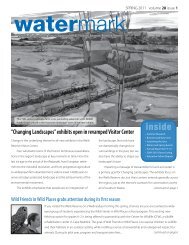Management Plan - National Estuarine Research Reserve System
Management Plan - National Estuarine Research Reserve System
Management Plan - National Estuarine Research Reserve System
You also want an ePaper? Increase the reach of your titles
YUMPU automatically turns print PDFs into web optimized ePapers that Google loves.
elow zero °F (-17.8°C) are recorded frequentlyeach winter. Cold waves sometimes come in onstrong winds, but extremely low temperatures aregenerally accompanied by light winds. The averagefreeze-free season is 139 days. Mid–May is theaverage occurrence of the last freeze in spring, andthe average occurrence of the first freeze in fall islate September.Vegetation and HabitatsThe vegetation of Gulf of Maine Coastal LowlandSubsection resembles that of the Atlantic CoastalPlain to the south. Ecosystems that reach theirnorthern extensions here include sandplain grasslands(found at the Kennebunk Plains Wildlife<strong>Management</strong> Area, located 6 miles east of the<strong>Reserve</strong>) and oak-hickory forests (found aroundMount Agamenticus). The largest coastal pitchpine communities in Maine occur on the welldrained,nutrient-poor sandy soils in Scarborough,Kennebunk and Wells. Small stands of pitchpine-scrub oak and the state’s most extensive saltmarshes are located in this region.Botanical surveys completed at the Wells <strong>Reserve</strong>in the 1980’s identified three major terrestrial habitattypes: upland fields and forests, wetlands, andbeach and dune.Upland Fields and ForestsPrior to European settlement, oak-pine forest coveredlands now encompassed by the Wells <strong>Reserve</strong>.Beginning in the mid 17 th century, forests werecleared for timber, farming and fuel. As farms wereabandoned in the 19 th and 20 th centuries, fieldswere largely supplanted by forests through naturalsuccession. The Wells <strong>Reserve</strong> at Laudholm Farmdisplays this land-use evolution with four uplandhabitats: mowed fields, old fields, oak-pine forestand mixed second-growth forest.Mowed Fields — With the decline of farming andmaturation of forests in New England, the <strong>Reserve</strong>’sopen fields and grasslands are valuable from aregional landscape perspective. About 90 acresare mowed annually to provide habitat for speciesrequiring grassland, early successional vegetativestages and large areas of open space. Keeping fieldsmowed also maintains a tie to the agricultural historyof Laudholm Farm.Old Fields — Adjacent to the <strong>Reserve</strong>’s mowedfields, two “old fields” are succeeding to shrubs suchas barberry, honeysuckle and bayberry. Apple andhawthorn trees line the field edges and hedge rows.White pine and poplar forests overtaking these oldfields contain herbs and grasses associated with oldfields.Oak–Pine Forest — An oak and pine communityoccurs adjacent to mowed fields on the northernupland portion of the <strong>Reserve</strong>. Red maple is amajor component of most of the oak-pine foreststands. Other tree species occur in the canopy orsub-canopy but do not attain dominance. At mostsites, heath shrubs dominate the understory, withblueberries being most abundant.Mixed Second-growth Forests — These woodshave been disturbed through harvesting or someother form of manipulation and lack strong characteristicsof a particular forest type.WetlandsFour types of major wetlands have been identifiedon the Wells <strong>Reserve</strong>: salt marsh, red maple swampand floodplain, shrub swamp, and brackish marsh.Salt Marshes — Covering about 1,200 acres, this isthe dominant sub-habitat of the Wells <strong>Reserve</strong>. Saltmarshes of the Little River and Webhannet Riverestuaries have formed behind double barrier spitsover the past 3,000 to 4,000 years. The marshesappear flat, but contain intricate drainage channels(natural and man-made) and creeks lined by smallcliffs or ridges and are dotted with pools and saltmarsh pannes. <strong>Plan</strong>t associations are complex.Red Maple Swamp and Floodplain — These arefound along the banks of the Merriland River andBranch Brook, as well as the lowlands between the<strong>Management</strong> <strong>Plan</strong>: Setting21




